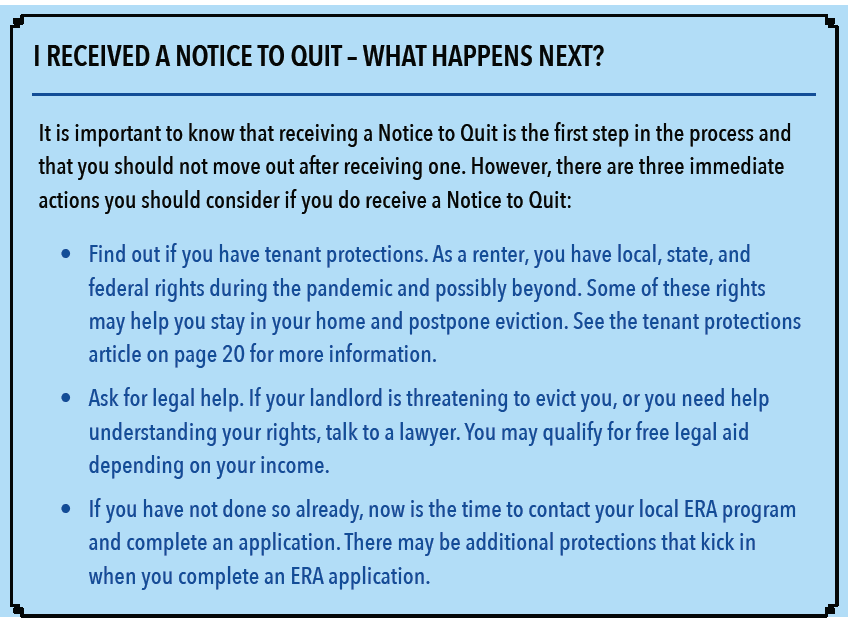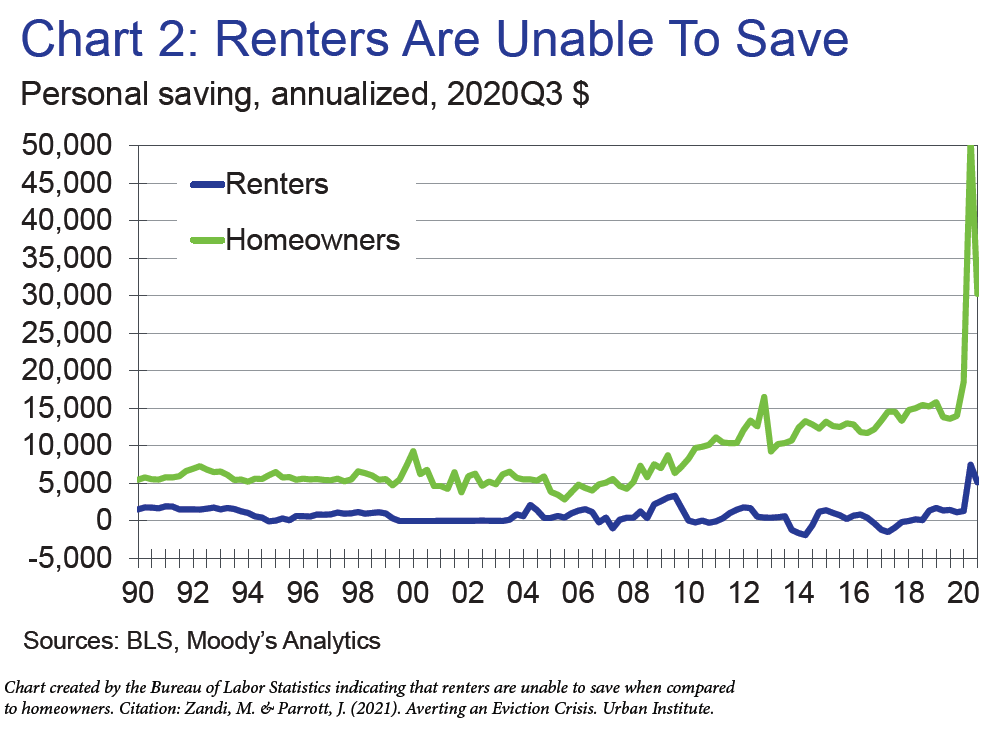Are you threatened with eviction because you owe several months of back rent due to pandemic-related disruptions? You are not alone. Many renters have been hit hard by COVID-19, losing their jobs, having to stay home to care for children and loved ones, and being forced to take on additional expenses related to working and schooling at home. If you are in a crisis and are unable to pay your rent, are behind on your rent, or are going into debt to make rental payments, there are some important first steps you should take to address your situation:
- Contact your local emergency rental assistance (ERA) program to check your eligibility for ERA and start an application.
- Then, contact your landlord to let them know that you applied for ERA and would like to make a plan.
How the eviction process works
Like other people, however, you may already be facing eviction. Even if you are, do not despair! The eviction process has several stages, and there are ways to avoid eviction throughout the process. Though the process can be confusing – and each state has its own rules, forms, and timelines that guide evictions for both landlords and tenants – there are five basic steps that you should know about.
Step 1: The Notice to Quit from the Landlord
If you continue to be late on your rent, your landlord may at some point give you a “Notice to Quit.” The Notice to Quit is a written notice provided by a landlord that states that a tenant is breaking a rule in the lease or is behind on their rent. This notice must be given in compliance with state and local requirements.
Common ways of serving the notice include:
- personal delivery to the tenant.
- taping the notice to the tenant’s front door.
- sending the notice through first-class or certified mail.

In the situation of nonpayment of rent, the Notice to Quit provides a deadline (three to five days in most states) for a tenant to pay the rent or move out (quit). After the deadline has passed, the landlord can file the eviction with the court.
Options to pay the owed rent may include:
- entering a payment plan.
- applying for rental assistance.
- making other plans to pay the owed rent.
Remember: A landlord cannot just lock you out, even if you are behind on rent. They must go through a process and get a court judgement first!
Step 2: The Summons to Court
If your landlord has provided a Notice to Quit but you haven’t moved out, paid the rent, or fixed the violation stated in the notice, your landlord must then file paperwork with the state or local court and serve you with a summons or complaint to move forward with the eviction.
The summons or complaint is an official court document that lets the tenant know they are being sued. It provides the date and time for a hearing or trial before a judge.
Remember: You MUST respond to the summons and/or show up to this hearing. If you do not show up, the judge will likely rule against you, even if you have a strong defense against eviction.
Step 3: The Court Hearing in Front of a Judge
The hearing is your opportunity to tell your side of the story. The judge or other official managing the hearing will allow both you and your landlord to present facts related to the case, including witnesses and evidence. You can bring your ERA application number to show you have a pending application. You can also bring rent receipts or other information showing your ability to pay rent or make a payment plan moving forward. The judge examines all the evidence, listens to each side of the story, and decides if the eviction is valid.
Remember: Know your rights and seek support!
Tenants are more successful in stopping evictions when they have legal representation. Unfortunately, research shows that more than 90% of landlords have legal representation compared to less than 10% of tenants. Several states have passed right-to-counsel legislation that provides free legal services to low-income tenants who are faced with a potential eviction.
Step 4: The Decision
After listening to all the witnesses and looking at the evidence presented by the tenant and the landlord, the judge will make a decision and write that decision up in an Order. If the tenant wins, the tenant can stay, usually subject to conditions. If the landlord wins, the judge will enter a judgment for possession (order of eviction).
Even if the judge decides against you, you may be able to file an appeal if you feel that the decision was wrong. In Connecticut, for example, tenants have five days to appeal a court’s decision. If an appeal is filed, the eviction will be stopped until a final ruling is made on the appeal. Otherwise, the eviction process will continue.
Step 5: The Notice to Vacate or Writ of Execution
Even if the landlord wins the eviction lawsuit, they cannot simply move you and your belongings out to the sidewalk. A landlord must give the court judgment to local law enforcement, usually along with a fee. A sheriff or marshal will give you – or post to your door – a final notice to vacate. This is a final notice to leave the rental unit and allows you time to move your belongings before law enforcement returns to remove them and escort you off the property.
